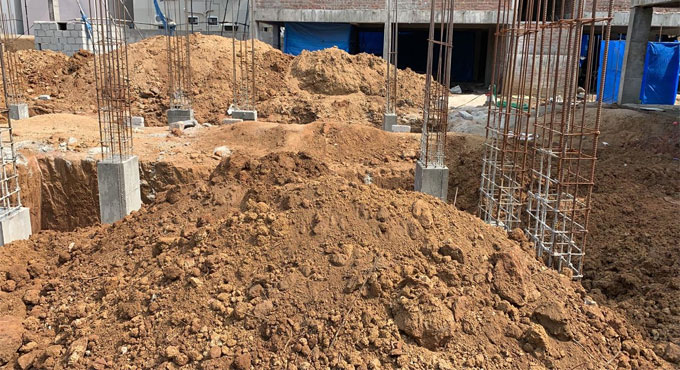NEWS | SOFTWARE | SHEET
Backfilling in Foundation Construction: Types and Procedures
Backfilling is a crucial step in the construction of foundations, playing a significant role in providing stability, support, and protection to the structure above. It involves the process of filling the excavated area around a foundation with soil or other suitable materials.
Proper backfilling not only ensures the structural integrity of the foundation but also helps prevent settlement, water infiltration, and other potential issues.
Before delving into the types and procedures of backfilling, it's essential to understand its importance in foundation construction. The primary objectives of backfilling include:
- Providing Lateral Support: Backfill material stabilizes the excavated area, preventing soil collapse and ensuring the structural stability of the foundation.
- Minimizing Settlement: Properly compacted backfill helps distribute loads evenly, reducing the risk of settlement and potential damage to the structure.
- Managing Water Drainage: Backfilling facilitates proper drainage around the foundation, preventing water accumulation and potential moisture-related issues.
- Protecting Foundation Elements: Backfill material acts as a protective barrier, shielding foundation elements such as footings and walls from external forces and environmental factors.
Types of Backfill Materials
Several types of materials can be used for backfilling, each with its own characteristics and suitability for specific applications. Some common types include:
Granular Backfill
Granular materials such as gravel, crushed stone, and sand are commonly used for backfilling due to their excellent drainage properties and ability to provide good compaction. Granular backfill is particularly suitable for areas with high water tables or where drainage is a concern.
Cohesive Backfill
Cohesive materials like clay, silt, and fine-grained soils are used as backfill in certain situations, such as filling around utilities or in areas where granular materials are not readily available. However, cohesive backfill requires careful compaction to minimize settlement and potential swelling.
Engineered Backfill
Engineered backfill materials, such as lightweight aggregates, cellular concrete, or geofoam, are used in specialized applications where specific engineering properties are required. These materials offer advantages such as reduced weight, improved drainage, and enhanced insulation properties.
Select Backfill
Select backfill consists of high-quality, well-graded materials that meet specified engineering criteria for density, particle size, and compaction. It is typically used in critical areas where structural stability and performance are paramount, such as beneath foundations or around retaining walls.
Backfilling Procedures
The process of backfilling in foundation construction involves several key steps to ensure proper placement, compaction, and drainage. The following are the typical procedures involved in backfilling:
Preparation of Excavated Area
Before backfilling begins, the excavated area around the foundation should be inspected and prepared accordingly. Any debris, loose soil, or organic matter should be removed, and the surface should be compacted and leveled to provide a stable base for the backfill material.
Installation of Drainage System
In areas prone to water accumulation or where drainage is a concern, the installation of a proper drainage system is essential. This may include perforated pipes, gravel trenches, or drainage blankets to ensure effective water management around the foundation.
Placement of Backfill Material
Once the excavation is prepared and the drainage system is in place, the backfill material can be placed in layers around the foundation. Care should be taken to avoid overloading the foundation and to ensure uniform distribution of the backfill material.
Compaction of Backfill
Proper compaction is critical to achieving the desired density and stability of the backfill material. Compaction can be achieved using mechanical compaction equipment such as vibratory rollers, plate compactors, or pneumatic tampers. The backfill should be compacted in thin layers to achieve the specified compaction density.
Sloping and Grading
The backfilled area should be sloped away from the foundation to promote proper drainage and prevent water from pooling around the structure. Grading the surface to direct water away from the foundation is essential for long-term stability and performance.
Protection and Restoration
After backfilling is complete, measures should be taken to protect the foundation from damage and to restore the surrounding area to its original condition. This may include installing erosion control measures, backfilling against foundation walls, and restoring landscaping features as needed.
Considerations for Successful Backfilling
To ensure successful backfilling in foundation construction, the following considerations should be taken into account:
Soil Properties
Understanding the properties of the backfill material, such as grain size, density, and moisture content, is essential for selecting the appropriate type of backfill and achieving the desired compaction.
Compaction Requirements
Proper compaction is critical to achieving the specified density and stability of the backfill material. Compaction should be performed in accordance with project specifications and industry standards to ensure long-term performance.
Drainage Considerations
Adequate drainage is essential for managing water around the foundation and preventing moisture-related issues. Installing a proper drainage system and sloping the backfilled area away from the foundation are important considerations for effective water management.
Structural Loads
Backfill material should be selected and placed in such a way as to minimize structural loads on the foundation and surrounding structures. Overloading the foundation with excessive backfill can lead to settlement and structural damage.
Environmental Factors
Consideration should be given to environmental factors such as climate, soil conditions, and groundwater levels, which can influence the selection and placement of backfill material. Specialized backfill materials may be required in areas prone to erosion, flooding, or seismic activity.
Monitoring and Inspection
Throughout the backfilling process, it is essential to conduct regular monitoring and inspections to ensure compliance with project specifications and industry standards.
This includes verifying the quality of backfill material, assessing compaction levels, and confirming proper drainage. Any deviations or deficiencies should be promptly addressed to prevent potential issues during construction or after project completion. By maintaining diligent oversight and proactive quality control measures, construction teams can mitigate risks and ensure the long-term stability and performance of the foundation.

Image Courtesy: avisunproperties.com

